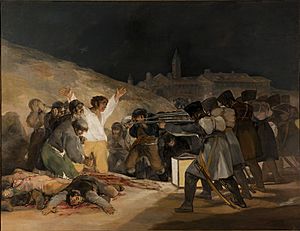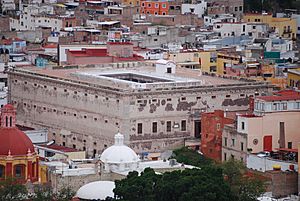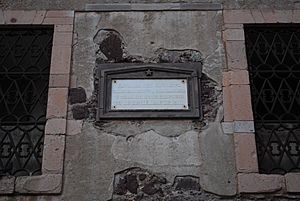Capture of Alhóndiga de Granaditas facts for kids
Quick facts for kids Battle of the Alhóndiga de Granaditas |
|||||||
|---|---|---|---|---|---|---|---|
| Part of Mexican War of Independence | |||||||
 The Battle of the Alhóndiga de Granaditas in Guanajuato on September 28, 1810, Oil on canvas, José Díaz del Castillo, 1910. |
|||||||
|
|||||||
| Belligerents | |||||||
| Commanders and leaders | |||||||
|
|
||||||
| Units involved | |||||||
| 50 000 | 2 500 Royalists | ||||||
| Casualties and losses | |||||||
| 3 000 | 2 200 | ||||||
The Battle of the Alhóndiga de Granaditas was an important fight during the Mexican War of Independence. It happened in Guanajuato, a city in what was then called New Spain (now Mexico). On September 28, 1810, Mexican rebels led by Miguel Hidalgo and Ignacio Allende fought against Spanish soldiers.
Many people in Guanajuato were scared. The city's leader, Juan Antonio Riaño, told everyone to hide in the Alhóndiga de Granaditas. This was a large building, like a granary, built in 1800. Miguel Hidalgo had even helped design it! After hours of fighting, Riaño was killed. The Spanish people inside wanted to give up. But the soldiers kept fighting until the rebels broke in. Sadly, many people, including families who had sought safety, were killed. Some historians say this event was more like a violent attack on civilians than a fair battle.
Contents
Why the Battle Happened
Spain's Problems and New Ideas
In 1808, there was a lot of political trouble in both New Spain and Spain. This led to new ideas about freedom and independence. These ideas became popular among people born in New Spain, called Creoles.
In early 1810, a group in Querétaro started planning a secret uprising. This group included Miguel Domínguez and his wife Josefa Ortiz de Domínguez. They were against the Spanish government, which was then controlled by Napoleon.
Leaders of the Uprising
Some military leaders, like Ignacio Allende, Juan Aldama, and Mariano Abasolo, joined the plan. They wanted a new government where the "true" king of Spain, Ferdinand VII, would still be in charge. But they also wanted more freedom for people in New Spain.
The uprising was first planned for December, then moved to October. But the secret plan was discovered on September 11. So, Miguel Hidalgo, a respected priest from Dolores, decided to start the uprising early. On the morning of September 16, he called for independence. This famous event is known as the Grito de Dolores.

Hidalgo's Growing Army
After the Grito de Dolores, Hidalgo quickly gathered about 6,000 men. In just a few days, his army entered San Miguel el Grande and Celaya without any fighting. There, he got more money and soldiers.
In a town called Atotonilco, Hidalgo took a banner of the Virgin of Guadalupe. This religious image was very important to the people of New Spain. It became Hidalgo's flag in his battles.
By September 24, Allende took Salamanca. Hidalgo was named Captain General of the Armies of America, and Allende became Lieutenant General. By the time they left Salamanca, Hidalgo had about 50,000 men ready to fight.
Spain's Response
The Spanish government quickly reacted. A new viceroy, Francisco Javier Venegas, was sent to New Spain. He was known for being tough. He immediately ordered his officers to stop the rebels.
Also, the bishop of Michoacán, Manuel Abad y Queipo, who was a friend of Hidalgo, officially removed Hidalgo and his followers from the Catholic Church. But Hidalgo ignored this and kept fighting for independence.
The Battle at the Alhóndiga
Hidalgo's Message to Guanajuato
Hidalgo sent José Mariano Jiménez, a miner, to Guanajuato. Jiménez's mission was to ask the city's leader, Juan Antonio Riaño, to surrender peacefully. Hidalgo wanted to avoid violence. Here's part of what Hidalgo wrote:
[...] I don't see the Europeans as enemies, but only as something that stops our plan. Please tell the Europeans in the Alhóndiga that they can either be our enemies or agree to be prisoners. If they become prisoners, they will be treated well, just like those with us now. Once we achieve freedom, they will become citizens and get their belongings back. If they don't agree, I will use all my forces to destroy them, and they will have no hope of survival.
Riaño was a Spanish naval officer who became the leader of Guanajuato in 1795. He was friends with Hidalgo. But when he received Hidalgo's letter, he refused to surrender. He said he was a soldier of the King of Spain and only recognized Viceroy Venegas as his leader. When Hidalgo heard this, he decided to attack.
The Attack Begins
Allende, Aldama, and Jiménez divided their forces to surround Guanajuato. At first, they met no resistance. In fact, they received money and more soldiers from the people. Some locals even gave them information about the Alhóndiga's defenses and the riches inside.
The fighting started around 8:00 AM. Shots were fired at the Alhóndiga. Riaño ordered Lieutenant Barceló to go to the roof to fight off attackers. Riaño stayed on the first floor, defending against the rebels. Barceló threw bombs and fired rifles from the roof.
Riaño realized his soldiers couldn't move freely. He decided to leave the building with a few men. But a rebel leader saw him and ordered an attack. Riaño was killed while trying to defend himself. His soldiers carried his body back inside.

A Trick and a Hero
After Riaño died, one of his advisors told Lieutenant Barceló to surrender. He even waved a white handkerchief on a rifle to signal peace. The rebels saw this and stopped fighting. Hidalgo sent Allende to negotiate.
But Barceló killed the civilian who waved the flag. He then went back to the roof and continued bombing the rebels. The rebels realized they had been tricked and started fighting again.
Hidalgo wanted to take the building, but it was very strong. Then, a brave miner named Juan José de los Reyes Martínez, known for his strength, asked Hidalgo for permission. He wanted to set fire to the Alhóndiga's main door. The door was reinforced with iron plates. Hidalgo agreed. El Pípila bravely went forward, carrying a large stone slab on his back to protect himself from bullets. He set the door on fire.
Inside the Alhóndiga
Once the door burned down, the rebels rushed inside. It was a terrible scene. Barceló and Riaño's son were killed. Many Spanish people and Creoles lost their belongings and their lives. The chaos wasn't just inside the Alhóndiga. For days, the city of Guanajuato was also looted.
Hidalgo tried to stop his soldiers from disrespecting his friend Riaño's body. He then saw the widespread looting happening in the city. On October 1, the rebel troops left Guanajuato.
What Happened Next
After leaving Guanajuato, the rebels headed towards Valladolid. When people in Valladolid heard what happened in Guanajuato, many fled. Valladolid fell easily on October 17. Then, on October 25, Toluca was taken. The rebels were planning to take Mexico City, which was known as "The city of palaces."
On October 30, the rebels won the Battle of Monte de las Cruces. They were eager to enter Mexico City. But Hidalgo decided not to attack the capital directly. Instead, he sent Mariano Abasolo and Allende to try to negotiate a peaceful surrender with Viceroy Venegas. The viceroy almost had them shot!
On the night of November 3, Hidalgo ordered his army to march away from the capital. On November 7, the Spanish army, led by Félix María Calleja, caught up with them in San Jerónimo Aculco. The rebels were defeated in what became known as the Battle of Aculco. After this loss, Hidalgo and Allende had a disagreement, and Hidalgo went to Valladolid, causing a split between them.
Remembering the Battle
The Battle of the Alhóndiga de Granaditas is remembered every September 28 in Guanajuato. There's a parade with students and government officials.
Also, on the 28th of each month, a special ceremony takes place inside the Alhóndiga. They light a "symbolic fire" of freedom. The Governor of the State and other important people attend this event.
See also
 In Spanish: Toma de la Alhóndiga de Granaditas para niños
In Spanish: Toma de la Alhóndiga de Granaditas para niños
- Miguel Hidalgo y Costilla
- Ignacio Allende
- Félix María Calleja del Rey
- Mexican War of Independence



